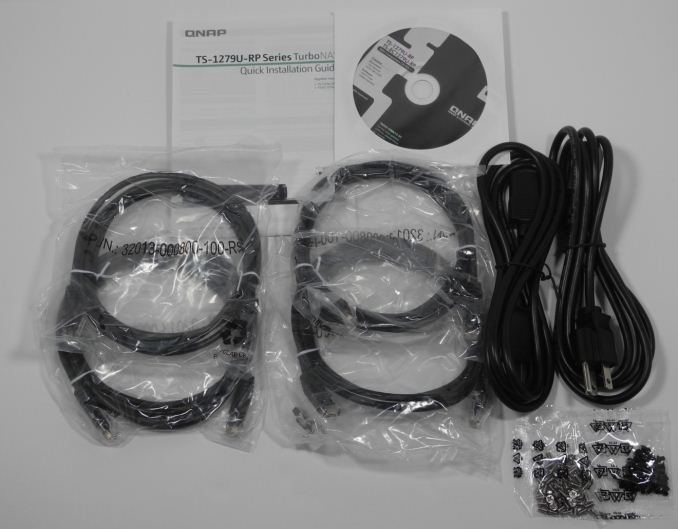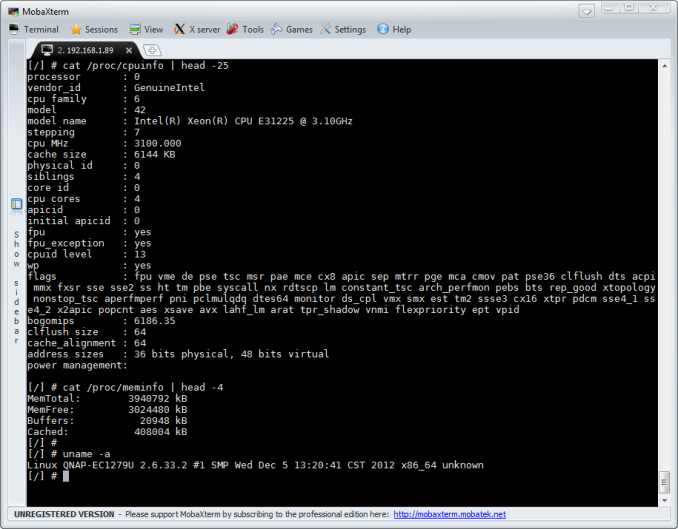QNAP's TS-EC1279U-RP 12-bay Flagship Rackmount NAS Review
by Ganesh T S on April 29, 2013 4:30 PM EST- Posted in
- Enterprise
- Storage
- NAS
- QNAP
Unboxing and Setup Impressions
The QNAP TS-EC1279U-RP package weighs in north of 50 pounds, with a diskless unit by itself coming in at 48 pounds (21.77 kg). As mentioned earlier, the unit is in the 2U form factor, with dimensions of 19" x 3.5" x 21". Along with the main unit, QNAP also bundles the following with the package:
- Quick Installation Guide and CD with QNAP utilities
- Four Cat 5e Ethernet cables
- Two US AC power plugs
- Screws for mounting hard disks in the drive bays
The front panel has twelve 3.5" drive bays arranged in three rows of four bays each. This leaves no room for a LCD display. The power button as well as status LEDs (network and power) are on the right side of the front panel. On the rear side, we have the VGA port for attaching a display, two USB 3.0 ports, two eSATA ports and four USB 2.0 ports. There are two GbE ports on the mainboard and two more on a half-height PCIe card. Two removable redundant power supplies round up the rear side of the unit. The power supplies are rated for 600 W each.
Inside the chassis, we have the E3-1225 CPU with a massive aluminium heat sink on top (passive cooling for the 95W CPU), one 4GB ECC DDR3 DIMM and a couple of spare SATA ports. The main board is isolated from the rear panel of the drive bays with three high speed fans which are user-replaceable (if the need arises). The SATA backplane consists of Marvell 88SE9125 SATA to PCIe bridges. There is one bridge chip for each SATA / SAS port, with a 6 Gbps SATA link on one side and a single PCIe 2.0 lane (5 Gbps) on the other.
On the software side, we found that not much has changed in terms of the UI since we reviewed the TS-659 Pro II. The setup process is very similar. There is an underlying assumption that the user / administrator is aware of various RAID levels (which is perfectly acceptable given the target market for this unit) as there is no automatic RAID level management. SSH access is available.
Even though multiple volumes can be created, a given disk can be a part of only one volume at a time. Disks can also be set up as hot spares. On the whole, the firmware has all the features that most IT admins would frequently use. In addition to the ability to configure the unit using the GUI, it would also be nice to have a CLI (command line interface) reference manual for this product level.
An overview of the setup process as well as the other features available in the current firmware is provided in the gallery below.
The firmware also comes with the ability to add more features using QPKG software expansion. There are a host of other features too, which we covered in detail in our review of the TS 659-Pro II. They are only of tangential relevance to this unit's target market, and hence, we won't go into detail into those features.
The disks can be set up in Single Disk, JBOD, RAID 0, RAID 5, RAID 6 or RAID 10 configurations. Available file systems are EXT3 and EXT4. Encryption is available on a per-volume basis.






























23 Comments
View All Comments
mschira - Monday, April 29, 2013 - link
I was wondering if one could install a proper Linux on these systems, such as Fedora.Then one could use it as a medium powerful computation server with lot's of local storage.
Has anybody tried that?
Cheers
M.
watersb - Monday, April 29, 2013 - link
It's a bit late for coffee, so please forgive me for not finding a price in the review.This looks like an interesting product, but I'm a ZFS zealot. Running ZFS with only 4 GB RAM isn't going to fly.
That said, I am *very* interested in anything resembling a mid-range NAS. Storage is a real pain point, and it is tough to build acceptable storage out of cheap disks. So thanks for reviewing this thing!
ganeshts - Monday, April 29, 2013 - link
Price is $5K (MSRP), but retailers are selling it at prices ranging from $3500 to $5000davegraham - Tuesday, April 30, 2013 - link
Watersb,Use Nexenta Community Edition (uses OpenIndiana + ZFS) on top of a supermicro server with the same 12 drive bays (and SAS drives) and I'd kill this particular box AND have a more robust solution to boot.
D
watersb - Tuesday, April 30, 2013 - link
Thanks, Ganesh, for the pricing info.Dave, that's such a good idea, I switched to OpenIndiana in 2009. I'm running 8 2TB drives as four mirrored pairs with a $100 LSI controller. But it will be quite some time before I have the budget to upgrade to a server motherboard with more than 16GB ECC RAM.
ZFS deduplication is *expensive*, folks. Don't do it. I tried adding a 60Gb SSD for L2ARC but it turns out that I would be better off with 60GB of *swap* to hold the deduplication tables.
My kung fu is weak. But I've been running this system through numerous hardware failures, PEBKAC events, and system software updates, and I haven't lost any data. Solaris isn't bulletproof, but it does warn me of impending drive failures before I lose anything.
Sorry for the long rant -- but it IS possible to play with "enterprise" class system configurations on lousy hardware if you are willing to waste^W commit some time doing so.
Walkeer - Thursday, May 9, 2013 - link
I do not understand either why such powerful NAS has only 4GB or RAM looking at the RAM prices these days...davegraham - Monday, April 29, 2013 - link
can you please nix the usage of the word "enterprise" from your reviews? These QNAP boxes (and pretty much any other storage device y'all review these days) are Commercial, SMB, or Consumer level devices at best. Enterprise describes a category of business that would never use this based on uptime, data integrity, performance, and capability requirements.ganeshts - Monday, April 29, 2013 - link
Hmm.. Not sure why you are doubting the performance and capability of these units. With SSDs, they form a very good storage backend for medium sized work groups. Uptime and data integrity - These need more QA, but with the stable firmware version, I really had no trouble keeping it bombarded with data accesses for days togetherGigaplex - Monday, April 29, 2013 - link
Read your very own "cons" section. This is exactly why Enterprise wouldn't look at it. As for performance? I've got a dirt cheap home build Llano box using 5 WD Green drives in software RAID 5 and it easily reaches 250-300MB/s transfers. This system had 12 SSDs. Colour me underwhelmed.Walkeer - Thursday, May 9, 2013 - link
I understand you have 10Gb network at home right? Or InfiniBand 4x perhaps? Else I do not see how you push 300MBps over 1Gb line... or you are talking about your desktop? Man, this article is about NAS...